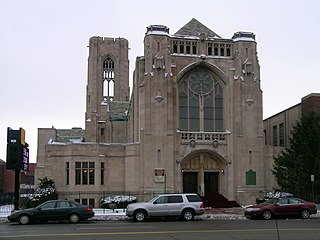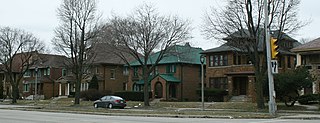
The First Church of Christ, Scientist is the administrative headquarters and mother church of the Church of Christ, Scientist, also known as the Christian Science church. Christian Science was founded in the 19th century in Lynn, Massachusetts, by Mary Baker Eddy with the publication of her book Science and Health (1875).

Solon Spencer Beman was an American architect based in Chicago, Illinois and best known as the architect of the planned Pullman community and adjacent Pullman Company factory complex, as well as Chicago's renowned Fine Arts Building. Several of his other largest commissions, including the Pullman Office Building, Pabst Building, and Grand Central Station in Chicago, have since been demolished. Beman designed numerous Christian Science churches and influenced the design of countless more.

First Church of Christ, Scientist, also known as First Christian Science Church Edifice, is a church building located in Oconto, Wisconsin. Built in 1886 of stone, weatherboard and brick in the Gothic Revival style, it was the first purpose-built Christian Science church edifice in the world. It was added to the National Register of Historic Places in 1974.

The First Church of Christ, Scientist building in Minneapolis, Minnesota, was the first of its kind in the state.

The First Church of Christ, Scientist at 339 West Kaufman in Paris, Texas, is a former Church of Christ, Scientist church and an historic structure that, in 1988, was added to the National Register of Historic Places. It was then vacant. In 2009 it was being used by a Spanish-speaking Baptist congregation.

The Central Woodward Christian Church, now known as Historic Little Rock Missionary Baptist Church, is a Gothic Revival church located in Detroit, Michigan. It was listed on the National Register of Historic Places in 1993.

The former First Church of Christ, Scientist, built in 1916 in the Classical Revival style, is a historic Christian Science church edifice located at 132 E. 4th Street in Neillsville, Wisconsin. It was designed in the form of a Greek cross by Chicago architect L. J. Corbey for Christian Science Society, Neillsville, which had been organized in January, 1912 and which later became First Church of Christ, Scientist. Its front portico is supported by four large Tuscan columns. While small in size, the building projects a large presence. Its auditorium windows are of green opalescent art glass. On March 31, 2003, it was added to the National Register of Historic Places.

The former First Church of Christ Scientist, is an historic Christian Science church building located at 315 Wisconsin Avenue, Madison, Wisconsin, United States. Built in 1929, it was designed in the Classical Revival-style by noted Madison architect Frank M. Riley. In 1982 the building was added to the National Register of Historic Places.

The former First Church of Christ, Scientist, is an historic Christian Science church building located at 700 22nd Street, Rock Island, Illinois, United States. Designed by architect William C. Jones of Chicago in the Palladian style, it was built between 1914-1915. Its exterior walls are of brick covered by Bedford limestone. Its superimposed front portico is supported by six 2 story columns with egg-and-dart capitals. Its dome actually consists of 2 domes: an outer dome and an inner dome which are separated by a space for lighting fixtures and maintenance. The inner dome consists of some 8,000 colored fish scale glass panes on a wooden support structure. The inner dome is similar to the inner dome of First Church of Christ, Scientist in Kalamazoo, Michigan, which was designed by William C. Jones in 1913.

The former First Church of Christ, Scientist, built in 1907, is an historic Christian Science church edifice located at 1443–1451 North Prospect Avenue in Milwaukee, Wisconsin. It was designed in the Classical Revival style by noted Chicago architect Solon Spencer Beman, who designed at least a dozen other Christian Science churches across the country. On March 8, 1989, it was added to the National Register of Historic Places. Today it is occupied by 1451 Renaissance Place and is the venue for weddings and other social events as well as corporate events.

The former Sixth Church of Christ, Scientist, built in 1902, is an historic Christian Science church edifice located at 1036 North Van Buren Street in Milwaukee, Wisconsin. In 1980 the building was added to the National Register of Historic Places. On May 17, 1983, Sixth Church was made a locally designated historic site by the city of Milwaukee.

St. Luke's Episcopal Church, Chapel, Guildhall, and Rectory is a historic church complex in Racine, Wisconsin. It was added to the National Register of Historic Places in 1979 for its architectural significance.

The Church Hill Historic District is a mid-to-upper-class residential area north of Portage's downtown. It was added to the National Register of Historic Places in 1997 for its significance in architecture and social history.

The North Sherman Boulevard Historic District is a largely intact neighborhood of stylish homes built from 1907 to 1955 in Milwaukee, Wisconsin. It was added to the National Register of Historic Places in 2004.

First Church of Christ, Scientist, Brisbane is a heritage-listed site at 273 North Quay, Brisbane City, City of Brisbane, Queensland, Australia. It was designed by Lucas and Cummings, Architects. It was added to the Queensland Heritage Register on 11 March 2016.

The former First Church of Christ, Scientist, also known as The City Church, is located in Cedar Rapids, Iowa, United States. Christian Science began in Boston in 1866 and it was introduced to Cedar Rapids twenty years later. A Sunday School was established in 1887 and it met at the old Dows Auditorium at Third Avenue and Third Street SE. The congregation was established in 1891 as an official branch of The First Church of Christ, Scientist in Boston. It was the first Christian Science congregation established in Iowa. They held their Wednesday evening services at the Peoples Unitarian Universalist Church. The congregation began construction on this building in 1914 and it was dedicated on Easter Sunday the following year. It is a red brick structure in the Neoclassical style. The rectangular building features a portico with four columns in the Doric order on the main facade, and a centered raised gable roof with cornice returns. The architectural style was chosen to "attract non-churchgoing people that may be intimidated by traditional religious structures." The congregation has subsequently moved to a new facility on Blairs Ferry Road, NE. This building was listed on the National Register of Historic Places in 2017.

The Northwest Side Historic District is residential district in central Stoughton, Wisconsin, United States with 251 contributing homes built from 1854 to 1930. In 1998 the neighborhood was listed on the National Register of Historic Places.

The Old Fourth Ward Historic District in Janesville, Wisconsin is a large old working-class neighborhood southwest of the downtown, comprising about 1100 contributing structures built from the 1840s to 1930. In 1990 the district was listed on the National Register of Historic Places.


















